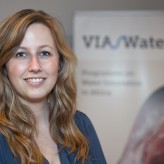Project Results:
Virtual latrines for improved sanitation
Using Virtual Reality to boost sanitation marketing
About
Project aimed to test the applicability of VR as a social marketing tool for sanitation. It holds the potential to become an effective marketing tool in Africa, since it eases the communication of complex messages and needs little literacy. Sales agents were equipped with a smartphone and a lightweight (low-cost) VR headset, as they went door-by-door. They demonstrated to viewers how a latrine - within their reach - can be incrementally improved to a bathroom. The pilot also collected evidence that VR can support latrine selling companies establish a more viable business.
Key results
-
VR Multi-Purpose Viewer developed and tested.
-
Proof of concept with 2 launching customers (Mozambique and Kenya).
-
Increased sales efficiency with 66%.
-
Great acceptance by both customers, sales agents and companies.
-
Start of a VR Community in Africa.
Tips for the future
-
A simple, clear design is most appropriate (no gadgets, films etc).
-
It is better to have 2 launching clients to cover the risk instead of 1. The first one (in Mozambique) withdrew from the project and it took 9 months to find another one (in Kenya).
-
The sanitation market is quite difficult, esp. with low purchasing power in Mozambique.
Potential for growth
There is no real uptake yet by the companies, but in case the VR were to expand with 2 companies per year, this would lead to 10,000 extra household customers having sanitation in 5 years’ time.
Project partners
NAISS, XL, FX Studio, BOP Inc.; followed by Sanergy and Black Rhino Ltd
Period
August 2017 - March 2019
Location
Maputo, MozambiqueLast project updates
Background
This project builds on prior successful collaborations between the applicants. XL and BoPInc have already worked together as complementary partners. XL is currently engaging with SNV to drive intent to purchase and positive behaviour change among households for sanitation. XL reached out to BoPInc to explore more innovative tools such as VR. This will strengthen XL’s social marketing toolkit aimed at organisations with sanitation businesses like SNV.
Project Plan
We will follow a lean innovation process with multiple design iterations to take as much learnings as possible on how to establish feasible and desirable solutions based on the novelties of VR technology. By doing so we integrate the technological developments with the business and ethnographic aspects of the application to avoid a traditional tech-push and create immediate ownership among the potential users of the VR marketing services which include the sales agents and their customers. The expected duration of the project is 9 months.
The project will be implemented in the operation area of Naiss, a Mozambican latrine selling venture: the ‘beiras’ of Maputo and in particular the KaMubukwane Urban District of Maputo. In this district there is a pressing need for improved sanitation among households with incomes below 8 USD/day. Naiss has an interest to become the early adopter of the Virtual Reality marketing concept which allows the team to take learnings and optimize the concept prior to spreading the service across other regions in Mozambique and throughout the rest of (East) Africa.
Activity 1: Insight collection and VR experiments
We collect research findings on the effects of VR marketing and prepare experiments with various kinds of content and interactions to demonstrate these effects with the Mozambican audience. This will inform us about what VR experiences are appropriate for the context. We will also shadow several sales agents to observe their sales pitches and identify effective emotional triggers that VR could tap into, which we will verify through a Focus Group Discussion with the same sales agents. These initial studies will lead to a list of guidelines for effective VR marketing for sanitation which will provide the boundaries for the design efforts under Activity 2.
Activity 2: Ideation, prototyping & testing
We co-create multiple ideas for VR experiences by leveraging the knowledge and creativity of the sales agents. After carefully reviewing the ideas we will produce 1 or 2 low-fidelity prototypes that will be qualitatively tested with a group of 20 households.These tests will take place in the field and focus on the general user experience and first observations of how it increases understanding and purchase intent among consumers.
Activity 3: Pilot of MVP
We develop 1 high-fidelity VR experience based on a defined MVP concept that incorporates all the learnings from former activities. This concept will be piloted among 100 households and focus on the increase on purchase intent as we will measure the interest of people prior to the VR experience, following a typical sales agent pitch, and after the VR experience.
Activity 4: Business development
We explore models for market-led implementation and scaling of the VR experiences based on a business proposition that optimizes costs versus behaviour change and sales increase. We will validate this business proposition by working closely with potential customers for these services.
Activity 5: Project Management & Communication
We manage budget, timeline, deliverables and coordinate the partnerships within and outside the core project team. We will also report to VIA Water during the project and contribute to the VIA Water community as well as the African community of VR enthusiasts that will play a role in driving the agenda for impactful VR applications in the continent.
Target group
The VR experiences will be delivered by the activation agents of sanitation organisations like Naiss. Many of these agents are low-income entrepreneurs and they will benefit from this innovation as they feel technically empowered and generate more prospects which will increase their income and job security. For the initial implementation and testing of the VR experiences, we will work with at least 10 sales agents. It is worth mentioning that Naiss sales team are employed agents that are obtaining strong support from a sales coordinator and management in strengthening the sales process and effectiveness. Naiss is using and further developing smart tools to support the agents in the field allowing the generate significant data on customers for their own processes but also to collaborate with partners that have an interest to reach these customers.
XL will benefit from this project as they can become one of the first VR service providers for improving sanitation in Africa. FX Studio will be trained by the VR experts of BoP Innovation Center to deliver VR content for the project.
Sustainability
While the primary focus of the project is to achieve Proof-of-Concept given the immature state of VR application in Africa, our project aims for sustainability. We do so by making the VR experiences part of a business proposition for social marketing services that private sector parties like XL distribute among clients seeking for cost-effective means to increase awareness and sales. For XL, the VR experiences do not stop at sanitation but they can also be used in the future as a marketing tool for other products such as clean cookstoves. At the same time, we are building local capacity of young tech entrepreneurs at FX Studio for the development of VR content tailored to local cultures. The innovations developed in this project will be used to inspire an even larger crowd of African entrepreneurs. By publishing online open source materials and attending events we aim to motivate young Africans to think of other impactful VR solutions for the continent.
Overview of Goals
This project aims to demonstrate that Virtual Reality experiences can be an effective tool for social marketing of improved sanitation. Specifically, the desired outcomes are:
Outcome 1: VR marketing contributes to an increase of at least 20% more purchase interest among peri-urban households in Mozambique
Outcome 2: Sanitation companies in Mozambique are willing to pay for VR marketing services
If Proof of Concept can be established, VR marketing can contribute to the public health and social economic well-being of the people that do not have their own improved toilet.
Results and indicators
- VR marketing contributes to an increase of at least 20% more purchase interest among the households
- Min. 3 different VR experiences (i.e. video recorded vs. computer generated content and interactive vs. non-interactive environments) co-developed and tested with 120 households.
- Min. 10 sales agents (Naiss) trained and supported on delivering VR experiences to peri-urban households.
- Sanitation companies are willing to pay for VR marketing services based on its cost-effective impact on increased purchase intent.
- Business proposition co-developed with 1 latrine selling company and tested based on a list of KPIs established with the company.
- Business proposition validated with 2 more latrine selling companies in Mozambique.



